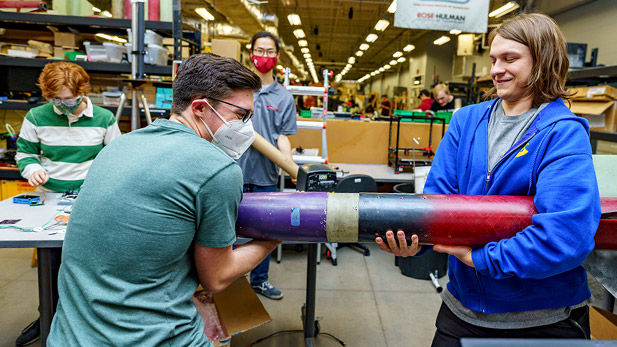Rose Rocketry Club Learns Valuable Lessons from NASA’s Student Launch Project

Rose-Hulman Rocketry Club established connections with Rose alumni working in the aerospace field, and were strong competitors in NASA’s 2022 Student Launch project.
In the mere two years it’s been on campus, the Rose-Hulman Rocketry Club has achieved several impressive accomplishments. The club boasts upwards of 30 members working on various rocketry projects. The group’s workspace went from two benches and 52-square-feet to a designated space in Branam Innovation Center. They established connections with Rose alumni working in the aerospace field, and were strong competitors in NASA’s 2022 Student Launch project.
Rocketry Club’s participation in the Student Launch project is the first time a campus group partook in this nine-month challenge that requires college students to follow the engineering design process used by National Aeronautics and Space Administration (NASA) and industry engineers for space exploration. Students design, build, test and fly a high-powered amateur rocket to an altitude between 3,500 and 5,500 feet. Student teams who complete all the required steps to NASA standards are invited to Huntsville, AL to fly their rocket and place in the competition.
While Rocketry Club was not able to complete a key component to compete at NASA, the team admits the experience of working together and building the rocket was an incredible learning experience.
“This is our first year participating in the competition,” says Ishaan Mishra, a physics major who just completed his first year. “Most club members didn’t have rocketry experience before coming to Rose. It was a huge step going from individuals building small Level 1 rockets to our final competition rocket that was 13-feet tall. The learning curve was steep, and everyone was actively participating.”
The competition process is extremely rigorous as it mimics exactly how NASA works, with the key difference being length of time to complete. NASA projects typically take five to 10 years; the student competition spans nine months. Team members estimate spending a minimum of 20-25 hours per week working on the competition. Rocketry Club members wrote a proposal, which was accepted, and then began work on the rocket and preliminary design report. They also wrote and presented to NASA judges a critical design and flight readiness report. The reports each totaled approximately 150 pages, making the total number of documentation close to 500 pages. Through the feedback process with the judges, Rose’s Rocketry team learned they had one of the largest rockets in the competition. It was also built using a pneumatic system, a much more difficult operating system than the electric system most teams used.
The NASA competition also gave Rocketry members the opportunity to connect with Rose alumni involved in the aerospace industry. After reading a Reddit post made by Rocketry Club, Louis Vaught, a 2015 civil engineering alumna, reached out to the team and offered to mentor them through the competition process.
Additionally, they learned valuable lessons from the process, which they believe, will guide them toward a win in next year’s Student Launch Project. Travel and operational costs are high, so the team is also trying to raise funds to support its efforts. Contributions can be made to the Rocketry Club at https://app.mobilecause.com/vf/RHRocketryClub.
“The hardest part of an engineering project is not the engineering or the technical aspects,” says Sam Betts, a mechanical engineering major and president-elect of Rocketry Club who just completed her sophomore year. “The challenge was the project management and technical writing experience and presentation skills. We can rise to meet the technical challenge, but the project management and logistical challenges were equally or more important. We really learned how to rise to those other challenges and that’s why we will be successful next year.”
In addition to the overall competition and project management portion, NASA presents a technical challenge as part of the Student Launch project. This year, teams were asked to create a GPS and positioning system to locate the rocket once it lands. This is also a challenge that NASA and the United States Department of Defense is trying to solve with its aerospace endeavors.
“We’re solving real problems,” says Garrett Hart, a computer engineering student and president of Rocketry Club who just finished his sophomore year. “Knowing the location issue is a real challenge that NASA is facing and needs solving, and hearing other engineers and Rose alumni tell us that’s a really difficult problem…that really put in perspective for me what we’re doing and why it’s so valuable.”